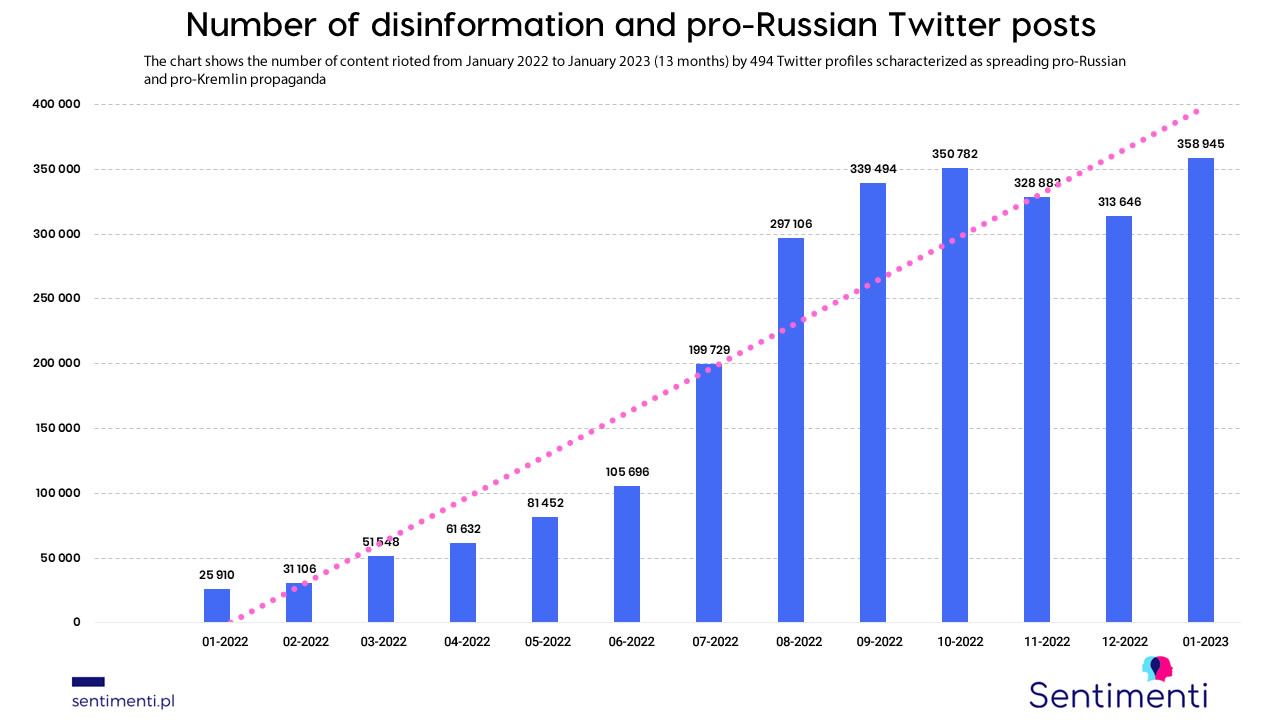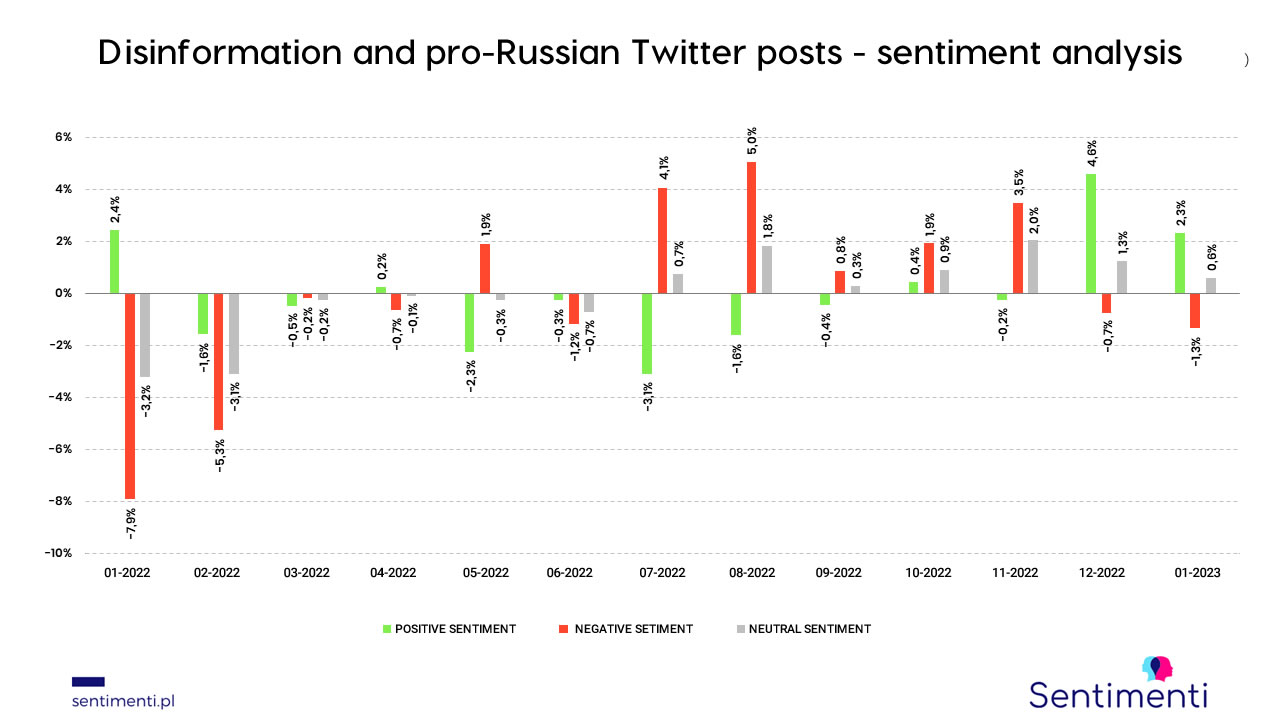Disinformation – a word that appears in the public space every day. Russia almost every day conducts an intensive disinformation campaign against not only Ukraine, but also Poland and countries that help Ukraine, both militarily and humanitarian. Every day we face a séance of hostility, but above all a flood of lies about us.
Disinformation and pro-Russian narrative on X (formerly known as Twitter). What is being written about?
Analysts and specialists in disinformation and cybersecurity agree here. The purpose of the online campaign, which has been ongoing since the beginning of Russia’s invasion of Ukraine, is primarily to provoke hostility and antagonize Ukrainians and Poles. With each month of the war in Ukraine, the scale of the attacks intensifies, and increasingly harsh accusations and threats are made against Poland.
According to Stanislaw Zharyn, who has recently been acting as the government’s plenipotentiary for the security of Poland’s information space, Russia is actively conducting a psychological operation against Poland and the West as a whole. The operation is aimed at intimidating and forcing submission to Russian imperialism.
Russian propaganda is constantly conducting online operations aimed also at intimidating Poles. On the Internet, all themes appearing in Russia’s popular propaganda programs are being expanded. We decided to check what kind of content is created by the most popular Twitter accounts known for sowing disinformation, fake news about the war and – generally speaking – for their love of Russia.
Russian propaganda regularly produces falsehoods about Poland. In the latest installment, it shows non-existent ads in the Warsaw subway allegedly recruiting Leopard tankers for Ukraine and suggesting Polish revisionism toward Ukraine. pic.twitter.com/6AJBBt91G8
— Wojciech Konończuk (@W_Kononczuk) February 2, 2023
We selected the 5,000 most popular posts (with the highest number of accumulated interactions) posted to this channel from each of the months between January 2022 and January 2023, i.e. for a full 13 months. A total of 494 profiles were manually monitored. The data collected in this way was further examined for emotion and sentiment, and we further examined which threads and thematic contexts aroused extreme emotion and generated high emotional arousal.
Among the online personalities we surveyed are mostly anonymous accounts and profiles, which often make typical Russian mistakes. They are created in part by transferring Russian content to Poland using automated free translation programs. Unfortunately, more influential people are increasingly included, spreading pro-Kremlin propaganda as a whole.
Festival of fake news and disinformation brings results
The incentive and starting point for our analysis was an article that appeared on gazetaprawna.pl (Polish). As we read in the material, titled “The Russian propaganda. “Poles increasingly susceptible to Russian propaganda [SURVEY],” recently there has been a strong increase in the number of people who more or less consciously share the theses circulated on the web that are part of pro-Russian disinformation. The Warsaw Enterprise Institute conducted its survey in this regard.
The results of the aforementioned survey show the same thing we see in the data we collected. Contexts of Ukrainian refugees, who are referred to as economic migrants, appear regularly. Even more frequent references are made to history, namely Volhynia and Bandera. Propaganda penetrates from Russia to Poland without any barriers via social media, but not only.
Returning to the 494 X (formerly known as Twitter) profiles we took under our magnifying glass, one thing strikes the eye above all. This is the extremely high level of activity. Some of the Twitter accounts are active to such an extent that it raises serious doubts about whether there are actually people behind them.

The Polish Anti-War Movement and the disturbing results of public opinion polls
The content is mass-collected in such quantities (200 or more posts a day) that it is challenging to imagine that the people behind it have anything else going on in their lives. There are also accounts that can flood a social network with several thousand pieces of content in a month. As for month-on-month increases in activity, for some periods the activity even increased by more than 80%. The trend is also noticeable and unambiguous.
What can be seen in the chart is, of course, only a slice of what is actually happening online. The point, however, is that this type of activity brings tangible results to those who conduct such a campaign online (increasingly, they also conduct it offline, i.e., on the streets of Polish cities).
The conclusions of the WEI study, as reported in Gazeta Prawna, are clear. In September 2022 and January 2023, the survey was conducted on 1,061 Poles. A comparison of the collected information yielded grim conclusions. , In January this year, as many as 41 percent of respondents (previously it was 34 percent) “strongly agreed” or “tended to agree” with a minimum of four statements characteristic of the Russian narrative
The opinions of Poles in this survey are very consistent with what narrative is served to them online, among other things. For 63 percent, Poland cannot afford to take in refugees. 41 percent are also convinced that refugees from Ukraine are economic migrants. 30 percent of Poles believe that we should not help Ukraine unless they apologize for the difficult history of relations between Ukraine and Poland. The group of Poles who believe that Russia should not be teased because it is a nuclear superpower has increased to 40 percent.
Content colluded by pro-Russian profiles online. What kind of sentiment?
Pro-Kremlin propaganda is beginning to increasingly shape what is going on in the minds of Poles. Declining support for supporting Ukraine or welcoming Ukrainians fleeing the war is a phenomenon that is occurring in parallel with what is happening to our economy.
Poles are increasingly connecting the dots and believe that the war is to blame for the fact that we have less and less in our wallets. This thesis is also being used in the narratives being spread.
The chart below is an analysis of the content we’ve gathered from nearly 500 profiles that colportage constantly pro-Kremlin content on X (formerly known as Twitter). Sentiment averaged negative on a monthly basis throughout the period analyzed, which is not surprising
However, not much variation in sentiment was noted for the entire 13-month period under study. What is clear, however, is how the narrative changed after the start of the war in February 2022, and that there was a marked jump in negative intensity.

Contexts and topics covered by disinformation accounts
When it comes to the content of posts uploaded to the web, we checked the ones that carry the greatest emotional charge. It’s all about anger or revulsion. The following analysis is the result of this. The different colors denote groups of topics. The color black identifies political topics. The red color is in contexts related to the war in Ukraine and derivative topics such as the Volyn slaughter, genocide and the military.
The yellow color refers to issues related to refugees from Ukraine. Blue tinges the topics related to energy and climate policy and raw materials. We were also able to isolate issues related to coronavirus, which we marked in green.
The analysis shows perfectly what the analyzed profiles are colporting. We can see what the intensity is in terms of topics and what issues are being covered. These accounts produce intensely content hitting the Polish government. They are also spreading disinformation in the field of health care or pandemics. We also see the topic of Ukrainian refugees and the impact of their presence in Poland on our economic situation.
Russian trolls will be colporteurizing more and more such information in the near future, as indicated, for example, by the first chart in this article. Soon we should expect – in connection with the planned and long-announced spring offensive – more uploads, but with strictly military topics (including mobilization in Poland, which is not present).
One can expect a difficult time ahead. It will be difficult to distinguish truth from lies, but the goal is invariably the same – to divide Poles and Ukrainians, Putin’s strategic goal.
